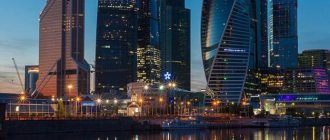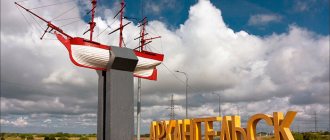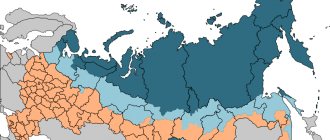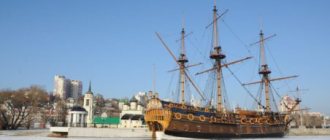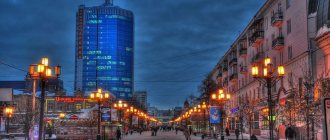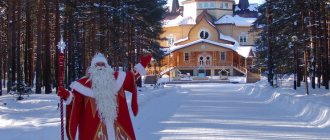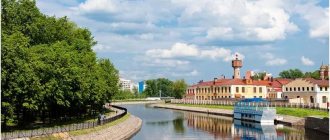Features of the geographical location of the southern part of Russia
The borders of the southern territory of our state are the waters of the Black and Caspian seas.
The South in our state includes the territories of the North Caucasus and Southern Federal Districts. They are characterized by the densest population density among others in our state. The southern territories of the state are conventionally divided into mountainous and flat. They are distinguished by their seaside location. From the eastern direction, they are washed by the Caspian Sea, from the western direction, they are washed by the Azov and Black Seas.
The state border passes through the southern territory of our state. Our neighbors from the south of the Russian state are: Ukraine, as well as Azerbaijan, Georgia and Abkhazia. The lowland south is characterized by highly developed transport lines. There are no railways in the mountainous south; they are laid only along the sea coast. The railway line runs through Sochi, Sukhumi and Derbent.
Soviet city
Rostov, which so actively did not want Soviet power, quickly began to pick up the pace of economic growth, and therefore prosperity. In the mid-20s, construction began on Rostselmash, a giant and leader of the domestic industry. A breakthrough was also made in the field of theatrical art: a theater building was built in the city. The names of the actors who worked here are known to the older generation: Yu. A. Zavadsky, V. P. Maretskaya, R. Ya. Plyatt.
In the fall of 1941, Rostov was occupied by German troops. A week later they were driven out by the army of S.K. Timoshenko. In July 1942, the city was again surrendered to the Nazis. Final liberation came in February 1943. During this time, German soldiers killed 40 thousand people, 53 thousand were forcibly taken to Germany. The city was almost completely destroyed; it was one of the ten most affected by the war.
Population and indigenous people of the South of Russia
Over 25 million people inhabit the southern part of our state. This amounts to almost 18% of all Russians. The southern territory is considered very populous, ranking first in the number of ethnic groups and nations.
The south of Russia does not have uniformity of settlement. The population reaches the largest numbers in industrial regions and on lands with developed crop production: in the Crimea and in the Krasnodar Territory, Rostov Region. In the North Caucasus, Russian nationality is not considered predominant.
For example, in Dagestan, Russian nationality is only in eighth place. On the lands of the Southern District, Russian nationality predominates over other nationalities. Krasnodar lands are the most densely populated. They are home to about 6 million people. On the Crimean Peninsula, Tatars are the indigenous population. Bakhchisarai is their main residence.
The Russian South has a diverse national composition. It unites several dozen nations, peoples and ethnic groups. The percentage of Russian residents of the South varies in different areas, but is considered predominant. Some of the most numerous nationalities of the South are: Chechen, Ossetian, Armenian, Ukrainian, Tatar, Ingush.
Novoshakhtinsky case
Meanwhile, government programs aimed at improving the living conditions of city residents are a “coin” with two sides. An illustration of this can be the already mentioned Novoshakhtinsk (Rostov region). After 1995, with the liquidation of coal enterprises, which were the only sector of the economy, the city of mining glory underwent serious transformations. The sharp reduction in jobs contributed to a large outflow of population in the first years after the liquidation of the mines, and, as a consequence, the vacancy of many land plots and private houses.
To support mining territories, development programs were developed at the state level, including providing citizens with social payments for residential premises damaged by mining operations in liquidated mines. These activities were developed by FBU GURSH (state institution for the restructuring of mines). Funds were allocated for two activities: the resettlement of citizens from dilapidated housing that became unsuitable as a result of mining operations at abandoned mines, and the demolition of dilapidated housing. Since 1995, the activities have been implemented by the mines, and after the liquidation of the mines, since 2002 they have been transferred to the administration of the city of Novoshakhtinsk.
Since 2005, large-scale construction began in the city, which was carried out at more than 20 sites. But since 2013, the amount of funds under the GURSH program began to decline. Despite this, the construction of houses continues to this day, but in a more limited manner. Over the entire period of implementation of the program, over 11 thousand people were resettled, which is about 10% of the total number of city residents, and over 6 billion rubles were used.
Government programs facilitated the relocation of citizens to new homes, but did not provide the necessary funds for the demolition of real estate properties remaining after relocation. Funds for demolition activities have not been allocated for about 10 years. Some areas are being developed with new residential buildings, while in others many apartment buildings remain to be demolished. Moreover, the mechanisms for transferring ownership of real estate during the resettlement process, which were poorly developed in the GURSH program, have led to the fact that today the majority of buildings recognized as dilapidated are in private ownership, which makes it impossible for the city administration to make decisions on their demolition without first conducting lengthy legal procedures.
Currently, in the city the problems of providing residents with square meters are not acute. Moreover, in the housing construction market, the only participants in shared construction are citizens receiving social benefits or participants in other housing programs. However, the problem with the demolition of dilapidated housing remains open.
Nature of the South of Russia
The relief of the southern part of our country is dominated by hills and mountains. Steppes and mixed forest zones have become widespread. Winters are often mild and summers are hot. Suitable conditions are being created for the development of agriculture and agricultural production.
The south supplies our state with grain, fruits and melons. The nature of the Southern Federal District is dominated by steppe, mountainous and mountain landscapes. The forests of the area are mixed.
Adygea has picturesque nature: vast forests, snowy mountain peaks, endless steppes and blooming alpine meadows. Steppes predominate in the Volgograd and Rostov regions. The Black Sea coast of the Caucasus is dominated by mountain forests with rich flora. Oaks and beeches grow in this area.
To the south of Gelendzhik, magnolia and palm trees grow. The nature of Crimea changes from north to south. In the northern part, in the Kerch region, hilly steppes dominate. A variety of grain crops are grown here. To the south, the steppes give way to forest-steppes, and then turn into oak forests. Oak trees occupy more than half of the entire territory of Crimea.
The southern part of Crimea is dominated by pine forests and juniper. The relief of the North Caucasus, in the northern part, is flat, and in the southern part, it is mountainous. The Caucasus is famous for its highest peaks: Elbrus and Kazbek. The soil in the region is fertile. The Western Caucasus is dominated by mountains, forests and meadows. From the foothills of the Caucasus Mountains to the peaks, the natural area changes. The steppes give way to forests, then meadows appear, and above, among the mountains, there is snow and glaciers.
Necessity
The development of the Russian economy is very closely connected with the historical, natural and regional characteristics of this country. There is a huge territory and large reserves of natural resources, most of which may still remain unexplored. Consequently, the role of centralized control of power has always been high. In addition to the borders and the center, it is also necessary to have control cells throughout the country. Considering the very large number of regions, as well as their desire to expand sovereignty, which weakens power, it was decided to create separate regional control centers that would be led directly by Moscow.
Climate of the South of Russia
The climate of the South of Russia is very diverse, depending on the area. The western part of the North Caucasus District is dominated by a temperate climate, which is characterized by heavy rainfall and warm, long summers.
From the east, in the Caspian lowland, the climate is hot and arid. In summer there is drought, dry winds and dust storms are frequent. Higher in the mountains, the climate is different. The higher the rise in the mountains, the lower the temperature. The winds blow constantly.
In general, the territory of the North Caucasus has a temperate continental climate, while on the Black Sea coast a subtropical climate prevails. In winter, it can be cold in the North Caucasus and snow falls.
In summer it gets hot with frequent thunderstorms and winds. In the flat territory of the North Caucasus, the summer period lasts 5 months. The climate in the Southern Federal District is generally moderately warm. But, depending on the territory, it may differ.
Kalmykia has a harsh, temperate continental climate. Summer is dry, with dry winds. The Volgograd region has an arid, pronounced continental climate. Winters have little snow, summers are dry. Crimea is distinguished by three climatic zones: the temperate continental steppe zone, the mountainous and subtropical zone of the southern coast.
The largest enterprises in the South of Russia
In the South there are many enterprises and factories specializing in the extraction and further processing of oil and its products, the search for minerals and various metals. In the south of Russia there are machine-building factories that produce equipment for production needs. The largest enterprises in the European South are recognized as:
– Plant producing pipes in Volzhsky;
– Astrakhangazprom;
– Afipsky Oil Refinery;
- RusAgro.
Agricultural machinery and equipment for oil refining are produced in Krasnodar, Rostov, and Novocherkassk. There are several oil refineries in Krasnodar and Grozny. There are also large agro-industrial complexes in the South.
Minerals of the European South of Russia
The Russian South is famous for its diverse and valuable mineral reserves. From the depths of the earth of the Crimean peninsula, the country extracts gas, iron ore, mineral salts, and shell rock.
In the North Caucasus, coal and oil, many non-ferrous and rare metals, salts, sulfur, marble and sandstone are mined. Kabardino-Balkaria is famous for its tungsten-molybdenum ores.
Oil is produced in Chechnya, near the city of Grozny. The Stavropol Territory supplies the country with gas. In Pyatigorsk and Kislovodsk, medicinal water with minerals is extracted.
Founding of Nakhchivan
After the founding of Rostov-on-Don, Empress Catherine II pursued a foreign policy aimed at weakening the Crimean Khanate, which was under Turkish control at the time. To achieve this, in 1779 she allowed the resettlement of Armenians from the peninsula to the lower reaches of the Don. In addition to weakening the economy of Crimea, Russia received on its territory a hardworking, Orthodox people capable of accelerating the development of the region.
12 thousand immigrants founded the city of Nakhichevan near Rostov, and the two peoples lived for many years in peace and harmony. By the beginning of the 20th century, the border between the cities was completely erased.
Agriculture and crops grown in the South of Russia
One of the priority sectors of the European South is the agricultural sector. Kuban and Stavropol are famous as the “Russian granary”. The black soil on these lands allows for the cultivation of many different crops.
The North Caucasus produces a variety of oils, sugar, vegetables and fruits, and sunflowers. Sheep are raised in livestock farming.
The production of national fermented milk products is widely developed: kumis, tan, ayran. The Krasnodar region produces many grain crops, such as wheat, buckwheat, corn, and beets.
Viticulture and winemaking are developed. Tobacco is grown.
Many large poultry farms and meat processing plants have been built on the territory of the Southern Federal District.
The main crop of Crimea is grain. More than 70% of the land is occupied by agricultural enterprises and farms. Cereals and melons are grown.
Many crops containing essential oils are grown. Carp and trout are bred in fish farms. Lowland areas make it possible to successfully raise cattle and engage in poultry farming.
Fine-wool sheep are bred in the Rostov region and Stavropol region. The Black Sea coast is favorable for growing grapes and various types of citrus fruits. Krasnodar tea is also grown there.
The south of Russia is like a health resort
The territories of the Krasnodar Territory and the Crimean Republic are famous as the best all-Russian health resorts. Tourists visit them all year round to treat various diseases and pathologies of the human body.
The best world-class balneological resorts are located in Crimea and the North Caucasus. Healing mineral waters and mud with brine help heal a variety of diseases. This has been tested by many generations of people in our country. The most popular health resorts in the South are:
– Mineralnye Vody, Zheleznovodsk, Pyatigorsk. Resorts have developed since the 19th century. Here, healing mineral water and medicinal mud are used for medicinal purposes;
– Hospitals of the Crimean Southern Coast: in Yalta, Alushta. They contain several preventive hospitals where treatment of the musculoskeletal system and respiratory diseases is practiced;
- Saki. Healing mud is extracted from Lake Saki, which cures many different ailments. Here they are cured of pulmonary diseases, various diseases of the spine and heart ailments.
Problems and prospects for the development of the South of Russia
The developing tourism sector is considered one of the main prospects for the economic development of the southern part of Russia. Recently, the tourism sector within the country has been successfully developing. The insufficient development of recreation and entertainment infrastructure in some regions does not allow attracting tourists from foreign countries.
The southern regions have reached a high level in agricultural development and are the breadwinners of the entire country. One of the problems in the South is the problem of dumping dirty wastewater. This is especially true for the Krasnodar Territory, where the sea, during the swimming season, is often polluted by microbes; every year there is a ban on swimming on the Black Sea beaches.
Due to the increasing development of cattle breeding, the ecological situation in pastures is deteriorating, and the Astrakhan region is becoming desertified.
One of the main environmental problems is soil restoration. To do this, it is necessary to carry out reclamation, land reclamation, and restoration of pastures.
In the field of tourism, it is necessary to continue to develop resort centers in Sochi, in the Caucasian Mineral Waters region, and in Dombay. It is necessary to rationally distribute tourists among resort areas, develop winter recreation, and apply flexible seasonal rates.
Is it better not to notice?
Despite the scale of population decline and the impossibility in many cases of reversing the process, cities and regions are reluctant to change their policies towards such areas, preferring to continue to program growth. This is natural for several reasons.
First, population decline is scary. It is associated with a weakening of military, political and economic influence at the national level, and therefore appears to be a highly undesirable development option. At the city level, population growth is an indicator of success in economic development and competitiveness. In the existing system of distributing budget funds between municipalities, population size plays a decisive role, which is why cities are trying so hard to maintain the status of “million-plus” or “hundred-thousand”.
Secondly, cities and regions often do not understand the real reasons for population decline - there is a tendency to simplify and form hasty conclusions without a careful analysis of the situation. A thorough demographic forecast for a city is rarely carried out - partly due to the lack of high-quality data, partly due to the lack of qualified specialists and funds.
An abandoned residential building in Novoshakhtinsk, Rostov region. A typical object of a city killing its population
PHOTO G. VIHRENKO
Thirdly, we simply do not know how to plan the development of cities in which further population decline is expected. Development is strongly associated with economic and demographic growth, as well as active construction. If a city is not built, then it does not develop. Therefore, all strategies and plans are focused on growth - the economy, population, square meters, kilometers of roads. And such an approach often seriously worsens the situation in conditions of depopulation - new residential areas and infrastructure become an additional burden for the city budget, which is always in deficit.
The situation is complicated by the fact that many Russian cities, even in the face of population decline, continue to experience a shortage of housing, social and engineering infrastructure, and are therefore forced to build. They build in the old fashioned way - by allocating new vacant territories for “comprehensive development”, to which they still need to bring transport and engineering infrastructure, build schools, kindergartens and clinics. At the same time, processes of erosion of the urban fabric, unnoticeable at first, are taking place inside the existing city - empty residential buildings appear, land plots that were once allocated remain undeveloped, abandoned industrial and public buildings are destroyed. All these inner-city areas are already provided with infrastructure, and it would be more logical to use them for development.
However, the implementation of such a development scenario is hampered by many factors. Municipalities often do not monitor property use and have no idea of the extent of the problem. In Russia, about 95% of the housing stock is privately owned, so disposal of abandoned buildings is possible only after complex procedures for declaring real estate ownerless and accepting it into municipal ownership. This requires time, money and human resources, which are always in short supply at the local level. Russian cities mainly receive funds for development from the federal and regional budgets through programs and projects that are usually not focused on solving such issues. It is much easier to obtain financing for new construction than for the repossession and dismantling of empty buildings. This is how partially realized residential areas arise outside the established city.



